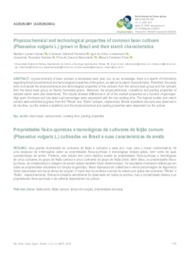Physicochemical and technological properties of common bean cultivars (Phaseolus vulgaris L.) grown in Brazil and their starch characteristics.
Physicochemical and technological properties of common bean cultivars (Phaseolus vulgaris L.) grown in Brazil and their starch characteristics.
Autoria: VANIER, N. L.; FERREIRA, C. D.; LINDEMANN, I. da S.; SANTOS, J. P.; BASSINELLO, P. Z.; ELIAS, M. C.
Resumo: A great diversity of bean cultivars is developed each year, but, to our knowledge, there is a dearth of information regarding the physicochemical and technological properties of the grains, as well as its starch characteristics. Therefore, this study aims to evaluate the physicochemical and technological properties of five cultivars from the carioca bean group and five cultivars from the black bean group as freshly harvested grains. Moreover, the physicochemical, crystallinity and pasting properties of isolated starch were also determined. The results showed differences in all of the studied properties as a function of genotype. High grain thickness and low seed coat percentage were associated with the low cooking time. The highest protein and starch content were exhibited by grains from the ?Pérola? and ?Estilo? cultivars, respectively. Similar crystalline structure was observed in all starches, but the relative crystallinity and the physicochemical and pasting properties were dependent on the cultivar.
Ano de publicação: 2019
Tipo de publicação: Artigo de periódico
Unidade: Embrapa Arroz e Feijão
Palavras-chave: Amido, Beans, Black beans, Cocção, Cooking, Feijão Preto, Feijão carioca, Pasting properties, Phaseolus Vulgaris, Propriedade Físico-Química, Starch
Observações
1 - Por padrão são exibidas publicações dos últimos 20 anos. Para encontrar publicações mais antigas, configure o filtro ano de publicação, colocando o ano a partir do qual você deseja encontrar publicações. O filtro está na coluna da esquerda na busca acima.
2 - Para ler algumas publicações da Embrapa (apenas as que estão em formato ePub), é necessário ter, no celular ou computador, um desses softwares gratuitos. Sistemas Android: Google Play Livros; IOS: iBooks; Windows e Linux: software Calibre.
Acesse outras publicações
Acesse a Base de Dados da Pesquisa Agropecuária (BDPA) para consultar o acervo completo das bibliotecas da Embrapa.

